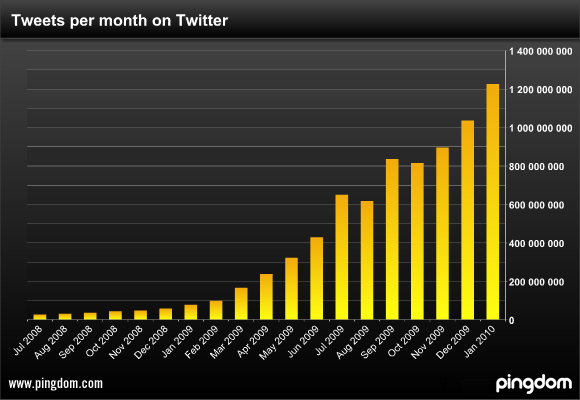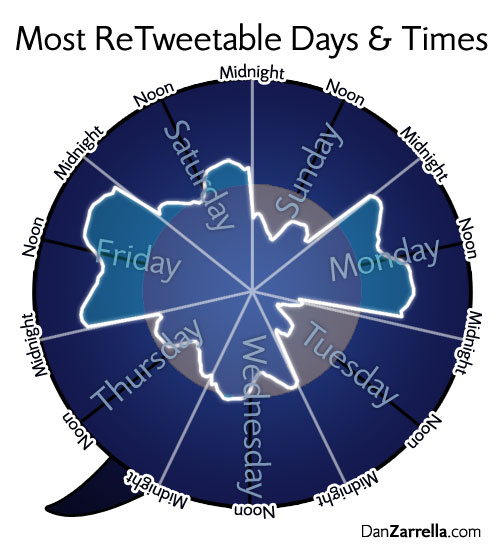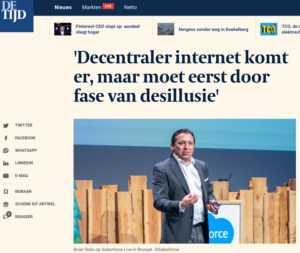The state and future of Twitter is passionately debated as users and industry pundits explore whether or not the platform and the relationships that connect one another are in danger of slowing or worse, regressing. Over the last year, Twitter experienced its most phenomenal growth to date, fueled by the adoption of the communication network by highly visible and influential personalities that attracted legions of new users to establish one-to-many and ultimately many-to-many connections. But, then the meteoric ascent practically leveled-off…
HubSpot released a new report that captures the state of the Twitterverse, opening a window that instantly transforms speculation into analysis and setting the stage for informed discourse and exploration.
According to the report, Twitter’s user growth peaked at 13% in March 2009 falling to just 3.5% in October 2009. And while this is the most recent date for which HubSpot has access, it is revealing nonetheless.

The steep decline, as I’ve said many times, has less to do with exposure and more to do with the initial Twitter experience for prospective users. Millions upon millions of new prospects are introduced to Twitter everyday by brands and media properties who place Twitter center stage in broadcast, print, and in person.
Follow us on Twitter.
Send us a Tweet.
Tweet us to win.
Receive special discounts, promos, and coupons just by following us.
Once they arrive at Twitter, there’s very little instruction or incentive to take the steps to not only create an account, but also adopt it as a form of daily or even weekly communication.


Although user adoption is slowing, existing users appear more engaged. According to the report, the average user is following a greater number of people and earning a greater reach through an increased number of followers. Existing users are also posting more content.

Once engaged in Twitter, the seduction of response, by a stranger or someone we know, combined with the allure of popularity is enticing and intoxicating. Many people fall victim to its addictive qualities as you are rewarded with feedback, connections, and presence through engagement. As such, Twitter is a rich network of opportunity to increase stature as measured through online social capital. Experienced users realize that the value of participatory media is powered by so much more than just simple tweets or conversations.
Paying it forward, reciprocity, and recognition are the investments we make in earning attention and awareness for the value we bring to the table.
When we realize that Twitter is far more than a tool to enliven self-actualization, “I Tweet therefore I am,” we uncork the essence of who we are today and who we wish to become tomorrow. As such, we embrace nuances of self-branding by presenting ourselves through bios, locations, and outbound profile links. Users are making the connection that they can define and shape the experience of those who clickthrough to their profile in order to better present the persona they wish rather than the personality left open to interpretation and perception.

Social Media is making this world a much smaller place, linking us through the words we place into action and the topics, interests and passions we share. We’re forging highly focused and expansive networks that engender opportunities for collaboration, education, and entertainment and as a result, we’re finding comfort outside of our comfort zones. We are now citizens of international provinces where we establish the governance and culture and set the course for our new found freedom.

Relationships are seemingly evolving into relations, where we invest in connections of those we know and also wish to know. However, while many users maintain following and follower networks numbering in the thousands, 82% of Twitter users maintain a network of less than 100 followers and 91% follow less than 100 people.

The Twitterverse is a living and breathing ecosystem that moves and adapts to current events and the moments of opportunity when someone is prone to sharing, responding, or viewing the activity of their friends and contacts. Dan Zarrella and I previously discussed the art and science of retweets, and in this report, HubSpot examined user characteristics and patterns of use.
What, when, and how we share, read, and bookmark tweets is governed by what I call the attention aperture. Our attention aperture opens and closes to match our daily regiment. We are only susceptible to learning at different times than we are to sharing. And through the analysis of the greater collective, we can observe patterns in this activity.
HubSpot observed that Thursday and Friday are among the most active days on Twitter, with each accounting for 16% of total tweets. Furthermore, 10 – 11 p.m. is the busiest hour on Twitter, accounting for 4.8% of the tweets in an average day.
HubSpot also documented the distribution of Tweets per day to get an idea of when people are updating their status, but also most likely, ready to be introduced to new, relevant content.


In the report published in collaboration with Dan Zarrella, we observed that Monday and Friday were among the greatest opportunities for retweeting as those windows represented ideal time frames for when the attention aperture was wide open.
Believe it or not, I’m often asked, “what’s the secret to retweets.” People are often introduced to formulas and methodologies that are questionable at best, but presented otherwise. My response is direct and honest, “say something worthy of retweeting.” And for good measure, I always throw in, “120 is the new 140. If you leave room at the end of your tweet for @username and potential commentary, you make it effortless for someone to RT you.”

Billions of Tweets Now Served
According to the data, it appears that the growth of Twitter is indeed leveling. However, existing usage is only skyrocketing among the core group of users who didn’t necessarily need Twitter to tell them how to get value out of ongoing engagement. According to recent research conducted by Pingdom, Twitter is serving more than 40 million tweets per day.
Most notably, on January 12th, 2010, Twitter co-founder Evan Williams published a Tweet that marked the company’s busiest day…
Across all metrics that matter, yesterday was Twitter’s highest-usage day ever. (And today will be bigger.)
In reviewing the astronomical rise of Tweets published by existing users, we see that Twitter is now serving more than one billion tweets per month – crossing over for the first time in December 2009.

From January 2009 to January 2010, the growth is practically blinding. Tweets, in just one year, ballooned 16x.
In the last three months, Twitter experienced month-to-month growth close to 17%.
November 16.8%
December 16.6%
January 16.9%
Pingdom estimates that Twitter will process around 1.4 billion tweets as soon as February 2010.
50,000,000 Tweets Per Day
We can’t help but feel like we’re running on a perpetual treadmill of rapid evolution courtesy of the blurring pace at which the real-time is Web is accelerating. When reviewing the recent Pingdom data, the first thing that comes to mind is, that was then, this is now.
Why?
In February, Twitter added its data to the mix revealing the magnitude and velocity of tweets. As of today, more than 50 million tweets are published in the statusphere, not to mention the distribution and syndication of those tweets across multiple social networks. According to the Twitter team, that’s an average of 600 tweets per second.
For perspective, in 2007, Twitter hosted 5,000 tweets per day. In 2008, the number climbed to 300,000 per day. In 2009, Twitter was publishing an astounding 2.5 million per day and over the course of the year, it soared to 35 million, up 1,400%
Folks were tweeting 5,000 times a day in 2007. By 2008, that number was 300,000, and by 2009 it had grown to 2.5 million per day. Tweets grew 1,400% last year to 35 million per day. Today, we are seeing 50 million tweets per day—that’s an average of 600 tweets per second.

The state of the Twitterverse or the Twittersphere if you will, has less to do with what “is” and more to do with what’s possible. I’m focusing my time on the latter. However, it takes Twitter, as a technology and as a business, to realize that what it is and what it wants to be, is distanced only by the actions it takes today. Meaning, the user experience starts upon the initial visit to Twitter.com and it continues long after registration. There’s much to be done – especially as Twitter has yet to truly demonstrate its value as an independent network for the masses.
I Tweet, therefore I am…part of a larger movement to expand awareness, literacy and connections that escalate causes and conversations that are greater than, but still complement, my purpose for engaging online.
Connect with Brian Solis: Twitter, LinkedIn, Tumblr, Google Buzz, Facebook
—
Please consider buying my brand new book, Engage!

—
Get Putting the Public Back in Public Relations and The Conversation Prism:









“The steep decline” statement you use to describe the Twitter growth rate is mis-leading. First, you have to consider the underlying base, which is becoming increasingly huge. So a growth rate of 3% last month might actually mean many new users added than a growth rate of 10% a year ago (off of a smaller base).
Second, Twitter users are increasingly turning to third-party apps like TweetDeck to manage their account. This usage is not included in the growth numbers. In fact, the only really relevant metric is probably the last one — Tweets per day, which captures usage from anywhere. The exponential growth depicted on this chart would suggest that Twitter is definitely not in “steep decline.”
Hi Mark, I can't disagree with you. I can only share what I know on the third-party apps. Believe it or not, they account for a minority of all users. I wrote about it before and the numbers are slowly changing, but not as dramatically as we'd hope…I'll rerun the numbers soon.
https://www.briansolis.com/2009/10/the-top-100-t…
I'm surprised to hear that a minority of users are using third party apps like Tweetdeck. I didn't “get” Twitter until I started using Tweetdeck and Hootsuite.
I'm also curious how the crackdown's on auto-generated spam accounts has affected the growth. It was rampant last summer and that may mean the number of real human's opening accounts hasn't dropped nearly as much as the data presents.
Doug
Not only that, this “steep decline” is a decline in the rate of growth in memberships, not a decline in membership numbers. An analogy might be slowing down on a freeway vs. backing up in reverse.
See also http://www.tweespeed.com for some Twitter Speed figures and graphes. Very interesting !
Mind-boggling numbers. It's amazing that anyone can be heard through the noise. And speaking of that, how DO you get heard through the noise?
I can't answer for Brian, but the reason I click on and read tweeted content is the fact that I know and trust that his content is consistently excellent, both well-written and informative. So I place him in my Twitter list of people I trust and view their column in Tweetdeck closely for new, compelling content. There's the key – publishing consistent, compelling, helpful content. After a while you can become well-known, especially if you put in the time and expertise. Then and only then, your tweets become valuable and get retweeted constantly.
John, well said. Attention is earned…appreciate it. 🙂
OK, but the question John answered is not the question I asked. I can tweet great content, use hashtags, and still not get heard. Part of that problem is the noise generated by so many tweets in such a short time. So beyond having excellent content — which I think even newbies know, John — how do you get heard above the noise?
well according to this it *isn't* noisy for almost everyone on Twitter:
“82% of Twitter users maintain a network of less than 100 followers and 91% follow less than 100 people.”
But I know I'll drop anyone who mentions their lunch or their cat more than once without a good joke or relevant piece of interesting information.
Laurie,
The best way to be heard is to listen.
Show interest in others before you can expect them to be interested in you. Retweet their content, thank them for their posts etc…actually engage them them.
Doug
Have to agree with Doug. You have to follow…really follow…not a token effort…in order to be followed.
Engagement is a critical piece of the online experience if your goal is to impact and be imapcted by the lives of the masses. If it is to impact the lives of only those you hold in your closest circle, you only need to use a phone – then, you become less than authentic even if you have perceived authority.
It will be interesting to see if twitter becomes a closed system as growth levels off. Granted, the average existing user is learning more about the system and the value it provides. If fewer users join it may become a very crowded space with everyone competing for the same “eyeballs.” I’m not certain twitter is there yet, since 3.5% user growth per month still amounts to over 40% annual user growth.
Another insightful post. Thank you Brian.
I think what is missing form these reports, and what Hubsopt is consistently missing from their research, is the breakdown of twitter usage by business and personal usage. Sometimes the line between the two blurs, but I suspect that the reason for the moderate growth in the number of users, but the big growth in usage, is due to higher usage of twitter for business purposes. The problem with these reports is that the personal usage skews the data so much, that business related decisions cannot be made based on them.
For example, the distribution of tweets by day and by hour shows that the busiest time, and maybe the best time, for tweeting is 10pm on Thursdays and Fridays, but would that be right for a business, or this data is skewed by personal usage? It make sense that 10pm would be a busy time for personal tweeting, after the kids went to sleep, or when the collage population is getting ready to go out…but can this really help me as a business, or more so, as a b2b business to decide when to tweet about my new offering, or a bout a great content I just posted or read?
Another problem is the use of mobile devices for tweeting. With an increase number of tweets from mobile devices (and again I suspect mainly for personal purposes), how would a business get his message out via twitter when the communication on mobile devices is basically one sided – people tweet their status, but not necessarily check other tweets.
What I'm trying to say is, that for businesses, especially b2b businesses, good data, and good research, about twitter, and how to use it is missing, and the personal use of twitter skews the aggregated data so much, that real, insightful, smart business decisions, are hard to make based on it.
Thanks again for this post Brian.
Uri
Very informative post and I love the graphs to really show the picture. I've personally noticed the increasing number of UK followers and their growth. No offense to other countries but people feel obligated to follow anyone who follows them but this is what brings the “noise”. Never feel obligated to follow someone simply b/c they follow you. A lot of top tweeters are followed by significantly more people than they follow with good reason. To keep down the noise…
This kind of in-depth research is why I <3 you, Brian! 🙂
“120 is the new 140″ is a mantra I tweet by… but now 120 has become more like 100 to allow for a RT of a RT and/or commentary. Obviously, the new “official” RT changes this too, should you choose to use it.
Interesting post. Some new users learn the ropes fast via friends help and other users trying to go it alone, may give up on Twitter. I joined Twitter a year ago and knew no one, but I have the skills to learn the ins and outs quickly. Twitter is increasingly being used by the media networks to improve the news and thus getting press, so I think that Twitter still has much more growth to look forward to. Currently, there is nothing quite as good as Twitter for the basic interaction and sharing capabilities that it provides.
I like your meta-analysis of the HubSpot report. Your observations about the seductive, enticing, intoxicating and addictive qualities of Twitter are well taken:
However, I think there are a number of trends that are diminishing the stature, or at least the ability to assess stature, on Twitter, and they have to do with abuses – or questionable uses – of the very features you note: paying it forward, reciprocity and recognition. As I wrote in a blog post about the commoditization of Twitter followers (which I might have subtitled How not to get retweeted), extrinsically motivated reciprocal following and retweeting – including fully automated systems for ensuring reciprocal followers, leading to an the instantaneous artificial inflation of 10,000+ followers (and followees) – significantly compromises the authenticity I believe is required for self-actualization … or attempts to derive meaningful metrics on the meaning of Twitter.
That is amazing the growth in number of daily tweets. WOW
@Greensboro_NC @NCmoz
If Thursday and Friday are the most active days on Twitter, I wonder if those also would be the best days to educate clients about Twitter – i.e. when their aperture is most open to learning something new. I often scratch my head to come up with ways and explanations to help push some clients to experiment with Twitter.
Fascinating summary, Brian. Thank you.
I enjoyed your presentation at the PRSA/Ragan Social Media Conference last week and have shared some of your key points with my team (we support a group of hospitals in Utah). It's quite overwhelming, but we, like many out there, are simply trying to take it one step at a time while trying to not get left too far in the dust.
Thanks again.
Brian,
Ordinarily you are spot on with your analysis but this time I think you've missed some big mistakes in the Hubspot report. I analyzed this Hubspot report in my post “A Flawed Analysis of Twitter” http://www.1goodreason.com/blog/2010/01/20/a-fl… where I took issue with the presentation and analysis of some of the data in the report. I particularly disagree with the Average Following and Average Followers figures. Meaningful data would be the Mean number of Followers/Following. Average is skewed heavily by high counts for a few celebrities. It is clearly wrong to believe that the average Twitter user has gone from following 40 users to over 150 users in a single year. And the Author of the Report agreed with me on this point.
I think that making any trends analysis based on the Hubspot report is very questionable. The presentation of the data is misleading and confusing and the data source is also questionable. In this case I think you need to reread the data and reconsider it's validity.
Chris
Chris – For the benefit of everyone on this blog, I am re-posting the comment I left on your blog article:
“Your assumption that the 5 million Twitter accounts that we analyzed are only people that visited Twitter Grader themselves is false.
The millions of accounts we analyzed do include Twitter users that were not typed in by the user themselves on Twitter Grader. We have an API in use by dozens of companies to grade Twitter users, plus other methods of growing the database, which provides a significant amount of data outside the visitors to Twitter.Grader.com.
We really do feel that the 5+ million accounts that we have data on are a pretty representative sample of the overall population on Twitter, and is the best dataset available outside of Twitter themselves.”
Mike,
I understand your assertion that the data set is valid. And it is possible that it is the best data outside of Twitter itself. My main contention is and has always been how the data is presented and what conclusions one is likely to draw from that presentation.
Looking at the follower and following charts above one would draw a conclusion based upon your data the average Twitter user follows 170 people and is followed in return by 300 while sending 400 updates per month. That data is so far from the numbers of any other report as to be unbelievable.
This is the basis of my argument, not the source of your data.
Brian,
What an interesting and thorough analysis of Twitter. Thanks for taking the time to share. I look forward to reading your book. I'm working on a presentation on Twitter for my colleagues and this info helps.
Mary Henige
Director, Social Media & Digital Communications
General Motors
@maryhenige
Mary, thank you! Looking forward to hearing what you think! 🙂
Excellent point that 120 is the new 140. I always leave room for RT but now, I'll leave room for commentary. Great tip!
Wow Impressive!
Your blog is very informative. However, it is pretty hard task but your post and experience serve and teach me how to handle and make it more simple and manageable.
Thanks for the tips… Best regards.
dissertation writing
this was indeed a very well researched post! i loved reading it. i also enjoyed reading this book on social media tips for professional services http://bit.ly/aQxde8
This was a very interesting post and it really helped me. Im a postgrad student at the University of Westminster studying Public Relations. One of my modules is PR and New Media where we do use twitter a lot. As a fairly new user this most has enlightened me in many ways.
I am currently working on a Twitter report for my organization and one of our initiatives. This information is great. I think it is going to help me establish some benchmarks for the next couple of months.
Unbelievable burst in tweets. I would do so more, but no one i know seems to have a Twitter account, and I don't fancy just telling cyberspace that i have just had a cup of tea and my biscuit fell in…
It is amazing how Twitter spreads the words, in just 140 characters people manage to send out news and information (I'm only considering relevant information). It has never been easier for PR to send out news avoiding journalist. I've only been using Twitter for about a month for my degree, and I'm astonished by people finding what i write and engaging in a conversation. I guess it is true when they say social media have no boundaries, anyone can talk to anyone!
This is an awesome look into Twitter by the numbers. I think that twitter will have some challenges continuing to be a vibrant community in the long run if they do not add fresh blood. That being said, many people who logged on and set up an account then did nothing may come back and test out the waters again. That is what I did with Twitter when I joined in February of last year. I determined it was not worthwhile, then started using the service on a more consistent basis in June and then added 30K followers.
The twitter is growing so rapidly. They stats that were surprising year ago seems like nothing in today’s situation.